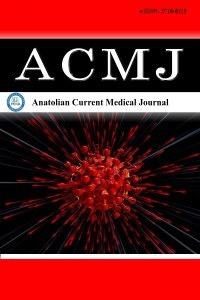Monocyte/HDL ratio in women with polycystic ovary syndrome and healthy controls
Monocyte/HDL ratio in women with polycystic ovary syndrome and healthy controls
___
- 1. Escobar-Morreale HF. Polycystic ovary syndrome: definition, aetiology, diagnosis and treatment. Nature Reviews Endocrinology 2018; 14: 270.
- 2. Bozdag G, Mumusoglu S, Zengin D, Karabulut E, Yildiz BO. The prevalence and phenotypic features of polycystic ovary syndrome: a systematic review and meta-analysis. Hum Reprod 2016; 31: 2841-55.
- 3. Cheang KI, Huszar JM, Best AM, Sharma S, Essah PA, Nestler JE. Long-term effect of metformin on metabolic parameters in the polycystic ovary syndrome. Diabetes and Vascular Disease Research 2009; 6: 110-9.
- 4. Randeva HS, Tan BK, Weickert MO, et al. Cardiometabolic aspects of the polycystic ovary syndrome. Endocr Rev 2012; 33: 812-41.
- 5. Sathyapalan T, Atkin SL. Mediators of inflammation in polycystic ovary syndrome in relation to adiposity. Mediators Inflamm 2010; 2010.
- 6. Wołczyński S, Zgliczyński W. Abnormalities of the menstrual cycle. Large Interna–Endocrinology 2nd edition Medical Tribune Poland, Warsaw 2012: 561-7.
- 7. Group REaSPCW. Revised 2003 consensus on diagnostic criteria and long‐term health risks related to polycystic ovary syndrome (PCOS). Hum Reprod 2004; 19: 41-7.
- 8. Kharitonenkov A, Adams AC. Inventing new medicines: the FGF21 story. Molecular metabolism 2014; 3: 221-9.
- 9. Bednarska S, Siejka A. The pathogenesis and treatment of polycystic ovary syndrome: What’s new. Adv Clin Exp Med 2017; 26: 359-67.
- 10. Patel S. Polycystic ovary syndrome (PCOS), an inflammatory, systemic, lifestyle endocrinopathy. The Journal of steroid biochemistry and molecular biology 2018; 182: 27-36.
- 11. Auffray C, Sieweke MH, Geissmann F. Blood monocytes: development, heterogeneity, and relationship with dendritic cells. Annu Rev Immunol 2009; 27.
- 12. Parthasarathy S, Barnett J, Fong LG. High-density lipoprotein inhibits the oxidative modification of low-density lipoprotein. Biochimica et Biophysica Acta (BBA)-Lipids and Lipid Metabolism 1990; 1044: 275-83.
- 13. Westerterp M, Gourion-Arsiquaud S, Murphy AJ, et al. Regulation of hematopoietic stem and progenitor cell mobilization by cholesterol efflux pathways. Cell stem cell 2012; 11: 195-206.
- 14. Kaplan I, Kaplan M, Abacioglu O, Yavuz F, Saler T. Monocyte/HDL ratio predicts hypertensive complications. Bratisl Lek Listy 2020; 121: 133-6.
- 15. Yakar H, Kanbay A. Could monocyte level/HDL cholesterol ratio predict cardiovascular diseases in patients with COPD? Niger J Clin Pract 2020; 23: 450.
- 16. Sirakaya E, Duru Z, Kuçuk B, Duru N. Monocyte to high-density lipoprotein and neutrophil-to-lymphocyte ratios in patients with acute central serous chorioretinopathy. Indian J Ophthalmol 2020; 68: 854.
- 17. Dincgez Cakmak B, Dundar B, Ketenci Gençer F, Aydin BB, Yildiz DE. TWEAK and monocyte to HDL ratio as a predictor of metabolic syndrome in patients with polycystic ovary syndrome. Gynecol Endocrinol 2019; 35: 66-71.
- 18. Usta A, Avci E, Bulbul CB, Kadi H, Adali E. The monocyte counts to HDL cholesterol ratio in obese and lean patients with polycystic ovary syndrome. Reprod Biol Endocrinol 2018; 16: 34.
- 19. Tedesco S, Adorni MP, Ronda N, et al. Activation profiles of monocyte-macrophages and HDL function in healthy women in relation to menstrual cycle and in polycystic ovary syndrome patients. Endocrine 2019; 66: 360-9.
- 20. Herlihy A, Kelly R, Hogan J, O'connor N, Farah N, Turner M. Polycystic ovary syndrome and the peripheral blood white cell count. J Obstet Gynaecol 2011; 31: 242-4.
- 21. Ibáñez L, Jaramillo AM, Ferrer A, De Zegher F. High neutrophil count in girls and women with hyperinsulinaemic hyperandrogenism: normalization with metformin and flutamide overcomes the aggravation by oral contraception. Hum Reprod 2005; 20: 2457-62.
- 22. Thomann R, Rossinelli N, Keller U, et al. Differences in low-grade chronic inflammation and insulin resistance in women with previous gestational diabetes mellitus and women with polycystic ovary syndrome. Gynecol Endocrinol 2008; 24: 199-206.
- 23. Orio Jr F, Palomba S, Cascella T, et al. The increase of leukocytes as a new putative marker of low-grade chronic inflammation and early cardiovascular risk in polycystic ovary syndrome. The Journal of Clinical Endocrinology & Metabolism 2005; 90: 2-5.
- 24. Diamanti-Kandarakis E, Paterakis T, Alexandraki K, et al. Indices of low-grade chronic inflammation in polycystic ovary syndrome and the beneficial effect of metformin. Hum Reprod 2006; 21: 1426-31.
- 25. Tsuboi S, Miyauchi K, Kasai T, et al. Impact of red blood cell distribution width on long-term mortality in diabetic patients after percutaneous coronary intervention. Circ J 2013; 77: 456-61.
- 26. Vayá A, Carmona P, Badia N, Hernandez-Mijares A, Bautista D. Association between high red blood cell distribution width and metabolic syndrome. Influence of abdominal obesity. Clin Hemorheol Microcirc 2011; 47: 75-7.
- 27. Yilmaz Ö, Mehmet C, Kelekci S, Temur M. Association between red blood cell distribution width and polycystic ovary syndrome. Endocr Res 2015; 40: 181-7.
- 28. Calan M, Yilmaz O, Kelekci S. Is elevated red blood cell distribution width a new risk factor for polycystic ovary syndrome? 16th European Congress of Endocrinology: BioScientifica; 2014.
- 29. Fujita B, Strodthoff D, Fritzenwanger M, et al. Altered red blood cell distribution width in overweight adolescents and its association with markers of inflammation. Pediatr Obes 2013; 8: 385-91.
- 30. Kajikawa M, Higashi Y. Triglycerides and endothelial function: molecular biology to clinical perspective. Curr Opin Lipidol 2019; 30: 364-9.
- Yayın Aralığı: 6
- Başlangıç: 2019
- Yayıncı: MediHealth Academy Yayıncılık
Kubilay SARIKAYA, Çağri ŞENOCAK, Mehmet ÇİFTÇİ, Muhammed Arif İBİŞ, Ömer Faruk BOZKURT
The effects of folic acid on vascular reactivity in a hyperhomocysteinemic rat model
Melek YILMAZ, Hüseyin GEMALMAZ, Cihan YÜCEL, Serkan KETENCİLER, Uğur GÜRCÜN, Berent DİŞÇİGİL
Dilara ÖZYİĞİT BÜYÜKTALANCI, Seyran YİĞİT, Sultan Deniz ALTINDAĞ, Hüseyin AYDOĞMUŞ, Servet GENÇDAL
Detected frequency of bacteremia in pressure ulcer and the decision to systemic antibiotic
Hasan ÖZTİN, Mete ERDEMİR, İlyas OZTURK
Handan ALAY, Sinan YILMAZ, Mehmet PARLAK, Fatma KESMEZ CAN, Nurdan PÜR
Surgical nurses’ knowledge levels about hemodynamic monitoring
Esra ÖZKAN, Nurşen KULAKAÇ, Ceyda UZUN ŞAHİN, Dilek ÇİLİNGİR
Mevlüt DOĞUKAN, Öznur ULUDAG, Mehmet DURAN, Murat Abdulhamit ERCİŞLİ, Kıymet CEYHAN, Cengiz GÜVEN, Ayşe BAYSAL
Müslüm SAĞIR, Mustafa KAPLAN, Alpaslan TANOĞLU, Fevzi DEMİREL
